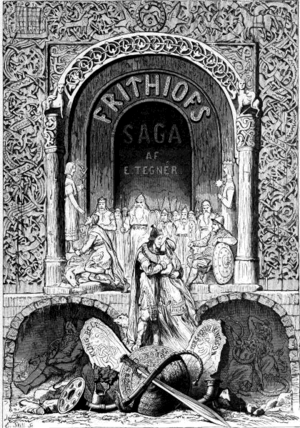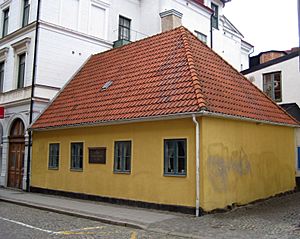Esaias Tegnér facts for kids
Quick facts for kids
Esaias Tegnér
|
|
|---|---|

Esaias Tegnér as portrayed by Johan Gustaf Sandberg, around 1826
|
|
| Born | Esaias Tegnér 13 November 1782 Kyrkerud, Värmland, Sweden |
| Died | 2 November 1846 (aged 63) Växjö, Småland, Sweden |
| Language | Swedish |
| Nationality | Swedish |
| Notable works | Frithjof's Saga |
| Spouse | Anna Maria Gustava Myhrman |
| Children |
|
| Signature | |
 |
|
Esaias Tegnér (born November 13, 1782 – died November 2, 1846) was a famous Swedish writer. He was also a professor of Greek language and a bishop. In the 1800s, many people saw him as the father of modern Swedish poetry. His most famous work is the epic poem Frithjof's Saga.
Contents
Growing Up and Education
Esaias Tegnér's father was a pastor, and his grandparents were farmers. His father changed their family name to Tegnérus, which Esaias later shortened to Tegnér. This name came from the village of Tegnaby in Småland, where his father was born. Sadly, Tegnér's father passed away in 1792.
In 1799, Esaias Tegnér started studying at Lund University. He had been taught at home before this. By 1802, he had earned his degree in philosophy. He then worked as a tutor at the university. In 1806, he married Anna Maria Gustava Myhrman, whom he had known since he was young.
In 1810, he became a lecturer in Greek. Two years later, in 1812, he was made a professor. He continued working at Lund University until 1824. That year, he was chosen to become the Bishop of Växjö. He lived and worked in Växjö for the next 22 years until he died.
Early Writings and Fame
Tegnér's writing career started a bit slowly. His first big success was a war-song in 1808. In 1811, his patriotic poem Svea won a major prize from the Swedish Academy. This award made him very famous.
In the same year, a group called the Gothic League was started in Stockholm. This was a club for young, patriotic writers. Tegnér quickly became their leader. The club published a magazine called Iduna. In it, they shared great poems and ideas. They especially wanted to encourage the study of old Icelandic literature and Norse history. Tegnér, Geijer, Afzelius, and Nicander were some of the most well-known members of this group.
Poems from Lund
Many of the poems Tegnér wrote while in Lund were short songs or lyrics. You can still see some of his work at the Tegnér museum today. His famous Song to the Sun was written in 1817.
He also wrote three longer, more important poems. These are the main reasons for his lasting fame. Two of these are the romance Axel (1822) and the beautiful poem Nattvardsbarnen (1820). The American poet Henry Wadsworth Longfellow even translated Nattvardsbarnen. In 1819, Tegnér also became a member of the respected Swedish Academy.
Frithjof's Saga
In 1820, Tegnér published parts of a long poem he was working on in Iduna. This poem was called Frithjof's saga. He published more parts in 1822, and the full poem came out in 1825. Even before it was finished, it was famous across Europe. The famous German writer Goethe praised it.
This romantic story was based on an old Norse legend. It had 24 parts, and each part used a different style of poetry. It was inspired by a Danish poem called Helge by Oehlenschläger.
Frithjof's saga became the most famous Swedish literary work in the 1800s. It was translated into English 22 times and into German 20 times. It was also translated into almost every other European language. While it might not be perfectly accurate to old history, it still gives a wonderful picture of life in early Scandinavia. A part of the poem was later used by the composer Max Bruch for his music piece Frithjof in 1864.
Later Years

The time when Frithjof's saga was published (1825) was a very important period for Tegnér. It made him one of Europe's most famous poets. It also meant he moved from his quiet study in Lund to the bishop's palace in Växjö. Around this time, his health also started to decline.
As a Bishop
It was quite unusual for someone with little formal religious background to become a bishop in Sweden at that time. But Tegnér accepted the role. It was a great honor, and he was not wealthy. He also wanted to leave Lund. However, once he started learning about his new duties, he began to have doubts. Still, he couldn't go back, and Tegnér served as a respected bishop as long as his health allowed. In 1835, he was also chosen as a member of the Royal Swedish Academy of Sciences.
Over time, he became sad and moody. In 1840, while visiting Stockholm, he became very unwell. He was sent to a special hospital in Schleswig. By early 1841, he had recovered and was able to return to Växjö.
In his later years, Tegnér started two more long poems, Gerda and Kronbruden, but he didn't finish them. He wrote Kronbruden while he was recovering in Schleswig. He didn't write much else of importance after that. In 1843, he had a stroke, and he passed away on November 2, 1846, in Växjö.
Tegnér Museum
The Tegnérmuseet is a museum dedicated to the life and work of Esaias Tegnér. It is located in the very house where Esaias Tegnér lived with his family from 1813 to 1826. This house is in the center of Lund. Since 1997, the museum has been part of the Kulturen foundation, which also runs an open-air museum in Lund.
Images for kids
See also
 In Spanish: Esaias Tegnér para niños
In Spanish: Esaias Tegnér para niños




